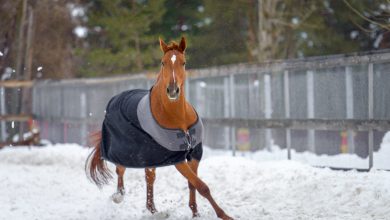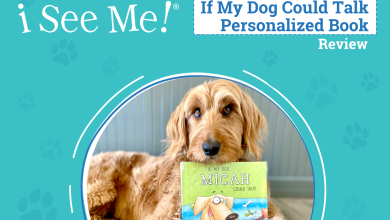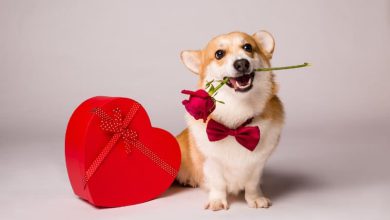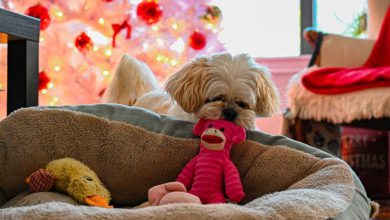Do Yorkshire Terriers Shed? Health Facts & Care Tips
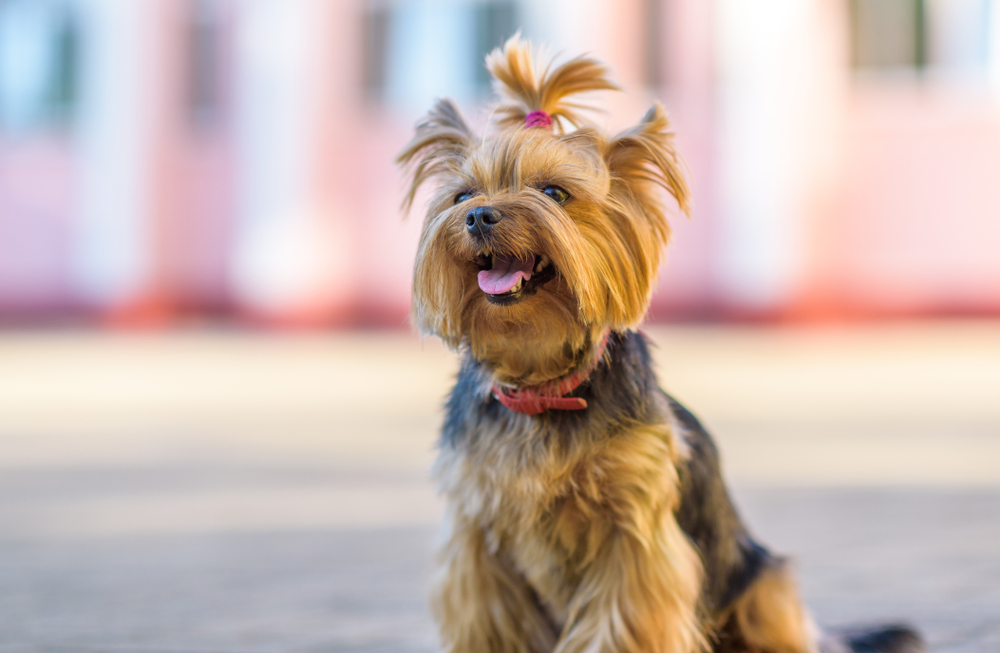
Yorkies are pleasantly easy to own for a broad assortment of pet lovers, partly due to their size and personality and partly because of their flowing low-shedding coats. Allergy sufferers tend to get along better with these diminutive dogs than they do with many other breeds. Yet, while they’re generally considered a hypoallergenic breed, Yorkshire Terriers still shed regularly.
The Yorkie’s relatively low-shedding coat requires a more involved grooming routine, a common trade-off in many dog breeds. We’ll explore the extent of a Yorkshire Terrier’s shedding and whether they’re as hypoallergenic as we like to believe.

Yorkshire Terrier Coat Characteristics
The Yorkshire Terrier is instantly recognizable in the show ring thanks to their adorable top knot and glistening, floor-sweeping coat. The coat is similar to human hair. It has long, fine strands and lacks the short, quick-shedding undercoat that defines double-coated breeds.
Double-coated dogs like Huskies or German Shepherds shed constantly and in high volume, covering their homes in fur throughout the year. When the seasons change, they blow their undercoat heavily. Spring is the heaviest coat-blowing period, as dogs lighten their coats to manage the warm weather and make way for new seasonal growth, demanding significant grooming and house-cleaning.
Yorkshire Terrier’s silky hair lacks this undercoat, so owners happily avoid any heavy shedding periods.
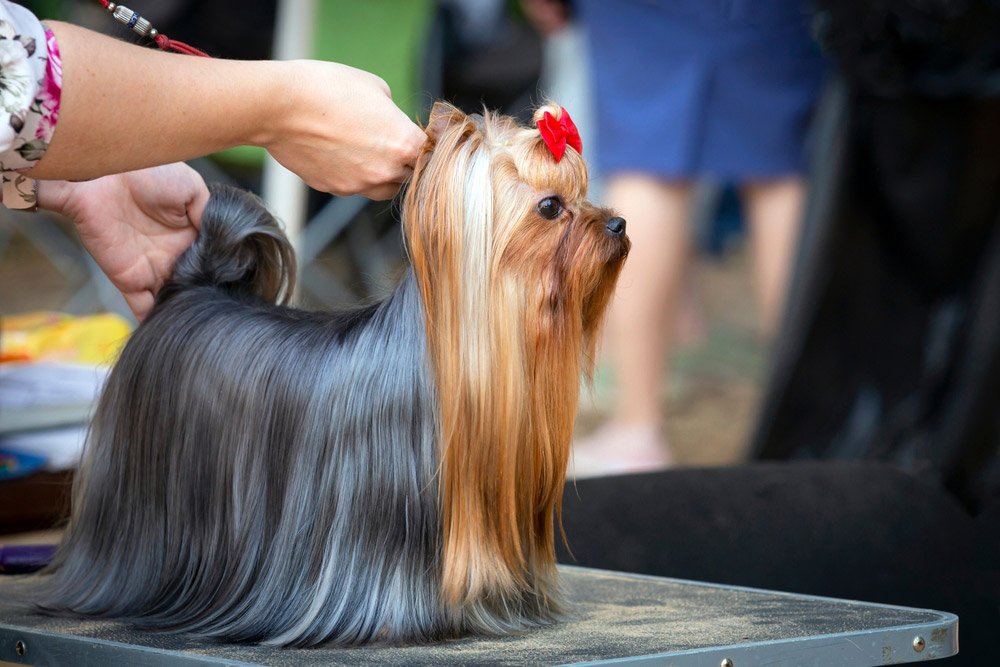
Do Yorkshire Terriers Shed?
Yorkshire Terriers may lack an undercoat, but they still shed hair. As dogs develop and maintain their bodies, the regular turnover of dead hairs to make way for new growth is a critical process.
With Yorkies, much of this hair falls back into the coat, and you can remove it in a controlled grooming session. Other hairs fall onto the ground, furniture, and anywhere else your dog frequents, but the buildup tends to be minimal compared to other breeds.
Low-shedding coats are a general hallmark of Terrier breeds. Since Yorkies grow much longer hair than many other dogs (and grow it continuously), the rate at which they must replace dead hair is relatively low.
When Do Yorkies Start Shedding?
Yorkshire Terrier puppies have a unique shedding period beginning at around 4–6 months. They lose their puppy coat, a thick and fuzzy layer, and transition to their silky, human-hair-like adult coat soon after.
At this time, the adult coat often blends with the puppy coat, allowing it to tangle and mat easily. Extra brushing and trimming can help manage the coat during this transition.




Factors Affecting How Much Yorkies Shed
Yorkies are generally a low-shedding breed, but each dog can vary in how much they release. Some of this is due to genetics, a factor owners can’t control, while lifestyle aspects can also have an impact. The following are essential reasons some Yorkies may shed more than others.
Diet
Feeding a Yorkie a balanced, complete diet is critical in ensuring their overall health and, subsequently, coat strength. Food rich in antioxidant vitamins and minerals can prevent damage to the skin and hair, while omega fatty acids can nourish, strengthen, and soften the body, promoting less hair loss.
Dietary intolerances can also affect hair loss in Yorkies. Even though your dog may be eating a nutrient-rich food that meets the AAFCO guidelines, they could have an allergy or intolerance to various components, such as dairy, certain meats, grains, or soy.
Allergic reactions can cause inflammation in the gut, hampering nutrient absorption and leading to poor body condition and coat quality. If your dog gets itchy skin, their coat can suffer, and the constant scratching can make them lose an excessive amount of hair.
Disease
Illnesses, particularly those affecting their hormones and immune system, may contribute to abnormal hair loss in Yorkshire Terriers. Common examples include hypothyroidism (underactive thyroid glands) and Cushing’s disease, an illness caused by excessive cortisol production. Many diseases appear later in life, typically when the dog reaches middle age.
Some Yorkies and dogs of other breeds, including Chow Chows, Dachshunds, and Doberman Pinschers, can also suffer a rare condition called color dilution alopecia. The genetically inherited condition affects areas with diluted pigments, causing hair to become brittle and loose. Although the dogs have normal hair at birth, they display abnormal hair loss in the darker coat sections between 6 months and 3 years.
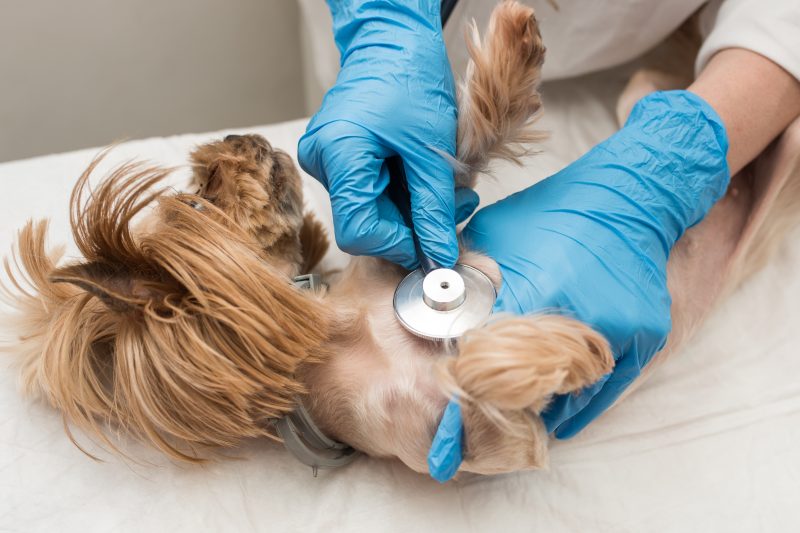

Stress
Stress, nervousness, and anxiety can have physical effects on a Yorkie, including causing unnatural hair loss. When dogs over-produce epinephrine (aka adrenaline) when they feel stressed, it stimulates hair to release. Reducing exposure to stressful stimuli and separation anxiety will usually resolve the problem.
Pregnancy
Pregnant Yorkies and those in heat experience a host of hormonal changes, with hair loss being one of many physical signs. Hair loss typically resolves after they give birth.
Infections
Parasites, bacteria, and other infectious agents, whether internal or external, can cause hair loss in various ways. Internal infections can cause malnutrition. External parasites damage and aggravate the skin, causing dogs to chew, scratch, and lick excessively and resulting in more shed hair.
Alongside regular vet visits, keeping your dog current on preventative medications for fleas and ticks is crucial in maintaining their overall health.
Grooming
Yorkshire Terriers need significant coat maintenance to ensure lustrous, shiny, and strong hair and prevent undue shedding. Understimulated and unclean skin can weaken its hold, while the hair can become dull, brittle, and more likely to break off.
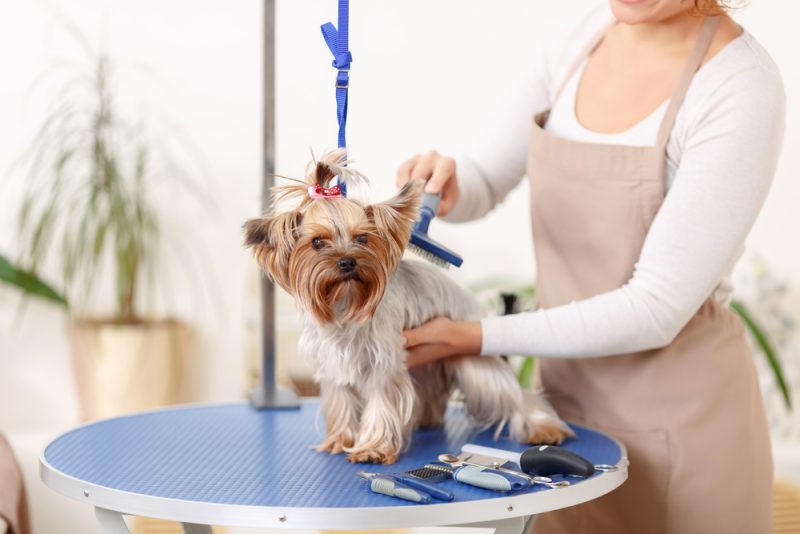



How to Groom a Yorkshire Terrier
Even though you won’t have to follow your Yorkie around with a vacuum cleaner, they generally need much more grooming than those that shed all the time. Since the long, single coat doesn’t stop growing, they’ll need trims every 1–1½ months. You can do this at the groomer or in your home with a quality set of clippers.
While show dogs have extra-long coats that reach the floor, owners can make grooming easier by maintaining a shorter puppy cut. Yorkies with longer coats need daily brushing. Meanwhile, those with shorter coats only need it once every 2–3 days.
Fortunately, Yorkshire Terriers don’t have wiry hair like many other Terrier breeds. Handstripping dead hair isn’t necessary. For owners on a budget, many of the grooming tasks, though time-consuming, are straightforward to do at home.
Brushing
Owners should have a pin brush, slicker brush, and combs to manage their Yorkshire Terrier’s coat. Using a conditioning spray before brushing is essential to reduce resistance and prevent breakage, which can cause more hair to come out with each pass.
Frequent brushing will prevent mats and tangles that can damage the coat. Gently work mats out with the slicker brush, and use combs to identify any minor tangles you may have missed. You should not brush an overly dirty coat, so assess whether your dog needs a bath before each grooming session.
Bathing
Yorkshire Terriers need a bath about once monthly, though some recommend more frequent baths every couple of weeks. While a high-quality pet shampoo is non-negotiable, a suitable hydrating conditioner can enhance the coat’s sheen, softness, and stability.


Are Yorkshire Terriers Hypoallergenic?
A truly hypoallergenic dog is a myth, and many labor under the misconception that Poodles, Doodles, Yorkies, and other “non-shedding” dogs won’t ignite their sensitivities. Shed hair is simply the vessel that spreads allergens around the home. The canine proteins that ignite signs appear in the dog’s dander, saliva, and urine.
Compared to other dogs, Yorkshire Terriers surprisingly produce more of the primary canine allergen, Can f 1. One study found Yorkies and Poodles are among the most allergen-producing dogs. Meanwhile, Labrador Retrievers, a heavy-shedding breed, produce the least.
Despite this, Yorkshire Terriers are an excellent choice for owners wanting to reduce dog allergens in the home. Yorkies shed little hair, limiting the amount of free-floating household dander. Plus, their minimal drooling further keeps the allergens on their bodies and off of household surfaces.


Final Thoughts
Yorkshire Terriers shed to an extent, but hair-covered surfaces are a rare concern with these toy dogs. If you can maintain a consistent grooming routine and support their overall health, they’ll reward you by keeping the household cleaning needs to a minimum.
Yorkies bring energy, excitement, and the endearing Terrier feistiness into the home, and their delightfully low-shedding coat is just one more reason to appreciate all these dogs can offer.
Featured Image Credit: shymar27, Shutterstock
